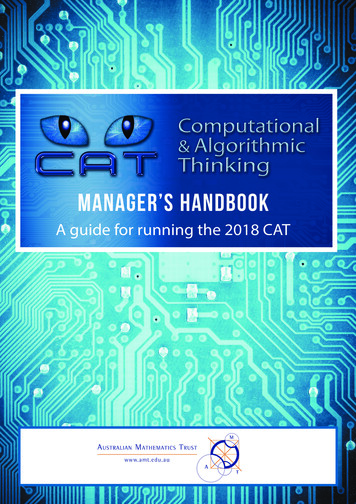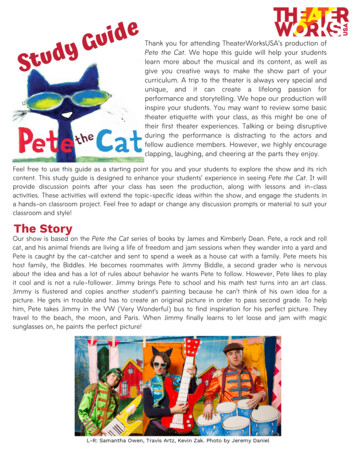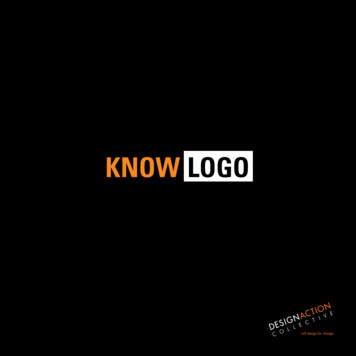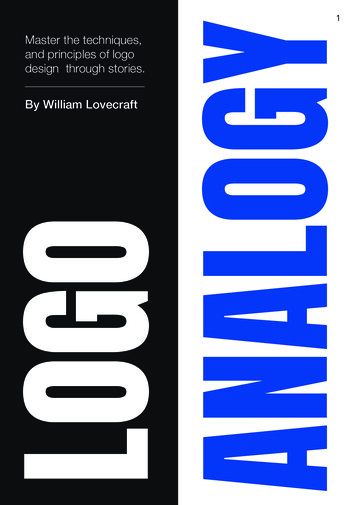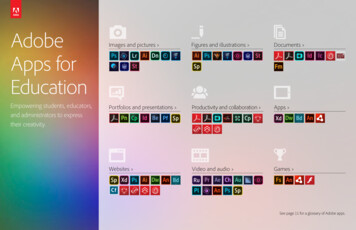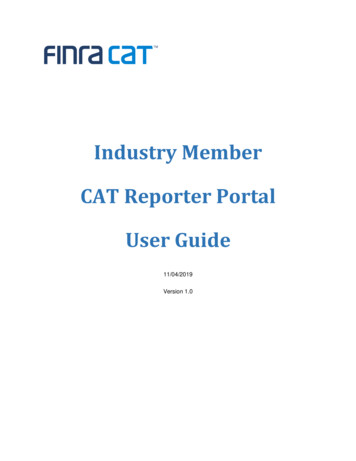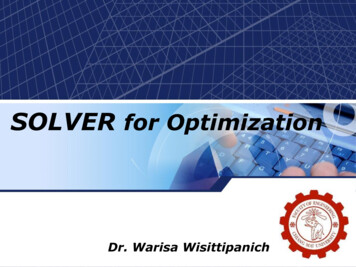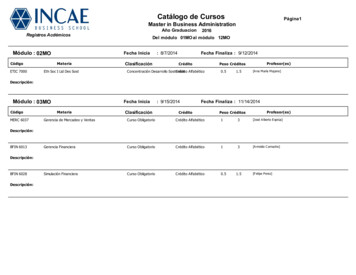
Transcription
New ReportCatálogo de CursosPágina1Master in Business AdministrationAño GraduacionRegistros AcdémicosMódulo : 02MOCódigoETIC 7000Del módulo 01MO al módulo 12MOFecha IniciaMateriaEth Soc I Lid Des Sost2016Clasificación: 8/7/2014Fecha Finaliza : 9/12/2014CréditoProfesor(es)Peso CréditosConcentración Desarrollo SostenibleCrédito Alfabético0.51.5[A na María Majano]Descripción:Módulo : 03MOCódigoMERC 6037Fecha IniciaMateriaClasificación: 9/15/2014Fecha Finaliza : 11/14/2014CréditoPeso CréditosProfesor(es)Gerencia de Mercadeo y VentasCurso ObligatorioCrédito Alfabético13[José A lberto Exprúa]Gerencia FinancieraCurso ObligatorioCrédito Alfabético13[A rnoldo C amacho]Simulación FinancieraCurso ObligatorioCrédito Alfabético0.5Descripción:BFIN 6013Descripción:BFIN 6028Descripción:1.5[F elipe Perez]
New ReportCatálogo de CursosPágina2Master in Business AdministrationAño GraduacionRegistros AcdémicosMódulo : 04MOCódigoBFIN 6061Del módulo 01MO al módulo 12MOFecha IniciaMateriaFinanzas Estratégicas2016: 11/17/2014ClasificaciónCurso ObligatorioFecha Finaliza : 12/19/2014CréditoProfesor(es)Peso CréditosCrédito Alfabético13[Jose Nicolas Marin]Descripción:Módulo : 05MOCódigoSOST 7021Fecha IniciaMateriaClasificación: 1/5/2015Fecha Finaliza : 1/23/2015CréditoProfesor(es)Peso CréditosFund Desar Sost RSEConcentración Desarrollo SostenibleCrédito Alfabético1.54.5[V ictor Umaña]Ética y Sociedad IIConcentración Desarrollo SostenibleCrédito Alfabético0.51.5[Julio Sergio Ramirez]Descripción:ETIC 7001Descripción:Módulo : 08MOCódigoMERC 6039Descripción:Fecha IniciaMateriaImplementación de Planes de MercadeoClasificaciónCurso Obligatorio: 3/23/2015Fecha Finaliza : 5/22/2015CréditoCrédito AlfabéticoPeso Créditos13Profesor(es)[Mateo Lesizza] [José A lberto Exprúa]
New ReportCatálogo de CursosPágina3Master in Business AdministrationAño GraduacionRegistros AcdémicosMódulo : 09MOCódigoADMI 6034Del módulo 01MO al módulo 12MOFecha IniciaMateriaAdministración de Proyectos2016: 8/17/2015ClasificaciónCurso ElectivoFecha Finaliza : 10/16/2015CréditoProfesor(es)Peso CréditosCrédito Alfabético13[F elipe Perez] [Yuri Kogan]Descripción:Módulo : 10MOCódigoITEC 7010Fecha IniciaMateria: 10/19/2015ClasificaciónFecha Finaliza : 12/18/2015CréditoProfesor(es)Peso CréditosGcia Tecnología Sist. InformaciónCurso ElectivoCrédito Alfabético13[German F ernando Retana]Inter Bus Trade and InvestmentConcentración Finanzas y EconomíaCrédito Alfabético13[V ictor Umaña]Descripción:BUSI 7001Descripción:Módulo : 11MOCódigoSOST 7011Fecha IniciaMateriaGerencia de la SostenibilidadClasificación: 1/4/2016Fecha Finaliza : 2/19/2016CréditoConcentración Desarrollo SostenibleCrédito AlfabéticoPeso Créditos13Profesor(es)[Rene C astro]Descripción:A nivel empresarial la sostenibilidad se confunde como medio ambiente, este es solo uno de los tres pilares de la sostenibilidad. Una empresa sostenible debe ser próspera, verde y justa. Examinaremos elorigen: la ecoeficiencia, la RSE y el reto actual de empresas que producen con baja intensidad de CO2 sus bienes y servicios. Las empresas y los países deben prepararse para el post 2020: el mundo debaja intensidad de CO2 por unidad producida.La Ecoeficiencia es una herramienta práctica que permite a los gerentes ser responsables ambientalmente y mejorar los rendimientos de los proyectos (combina dos componentes de la sostenibilidad). Unaempresa que aplica la eco eficiencia en sus proyectos y en la toma de decisiones puede alcanzar una posición eco/competitiva en el mercado. La filantropía mezcla las utilidades y la proyección social deuna empresa (de nuevo dos componentes de la sostenibilidad).En este curso se enfatizará la identificación de proyectos de emprendedurismo, la adquisición de competencias y herramientas por parte de los estudiantes y se dará importancia a valores compartidos yde trabajo en equipo. Se hará énfasis en los casos y “casos vivos” la eficiencia energética, al uso racional de materias primas como el agua y a los insumos necesarios para la producción pero también sediscutirá la necesidad actual de obtener licencias ambientales y sociales en proyectos públicos y privados en la sociedad interconectada del siglo XXI. Se estudiarán casos exitosos, neutros y fracasos envarias empresas Latinoamericanas y globales.
New ReportCatálogo de CursosPágina4Master in Business AdministrationAño GraduacionRegistros AcdémicosMódulo : 11MOCódigoDel módulo 01MO al módulo 12MOFecha IniciaMateria2016Clasificación: 1/4/2016Fecha Finaliza : 2/19/2016CréditoPeso CréditosProfesor(es)Este curso comprende los elementos técnicos básicos para entender cómo se agrega o destruye valor a bienes y servicios producidos, para el análisis del uso de recursos y de la energía en procesosproductivos a nivel de empresas e incluso de regiones y países.Objetivos generalesa)Adquirir las herramientas para realizar análisis de productos y servicios de diversas empresas que quieran hacer de la sostenibilidad parte de su estrategia y posicionamiento.b)Fomentar la adopción de una perspectiva estratégica transdisciplinaria que incluya los aspectos económicos, sociales y ambientales, orientada a reforzar las ventajas competitivas de la empresa.c)Introducir al estudiante a los conceptos básicos de ecoeficiencia como subcomponente de la RSE y a las herramientas de aplicación.Metodología de enseñanza y participación en claseSe espera que cada estudiante haya leído por adelantado el material correspondiente y en caso necesario haber consultado ya sea conmigo, con su grupo, o con otros compañeros aquellas dudas que sepresenten al hacer las lecturas o resolver los casos.Cuando se tenga invitados y casos vivos se espera de los estudiantes la lectura del material teórico e investigación de la empresa en redes sociales. Se dará el mayor peso en la nota, a la identificación yevaluación de un proyecto de emprendedurismo sostenible (detalles a discutir en clase).Los estudiantes deberán prepararse para los casos y los “casos viv os” en grupos de 4 personas (como máximo) y cuando se les informe con anterioridad, deberán entregar la solución por escrito (unacopia por grupo) en las fechas establecidas. No se aceptarán entregas tardías de casos. Nunca está de más recordarles que la participación en clase será medida por su calidad y no necesariamente porsu cantidad.Sistema de EvaluaciónParticipación en clase: 20%Casos 20%Examen Parcial (identificado y evaluando ideas para proyectos de emprendedurismo sostenible) 35%Examen Final: 25%TDEV 6002E-BusinessCurso ElectivoCrédito Alfabético13[Pedro Rav entós]Descripción:COURSE DESCRIPTIONWeill & Vitale define eBusiness as buying, selling, marketing, distributing, servicing and paying for products, services and information using netw orks that connect firms w ith their clients, agents, suppliers,competitors and complementors.eBusiness is not, as sometimes thought, mainly about technology. It is about business, in particular about clear, w ell founded, business logic. While a lot of money has been w asted on expensivetechnologies, poorly suited to firms' strategies, some of the most dramatic changes, like those that have been occurring in the Costa Rican tourism industry, have been based on simple technologies.eBusiness helps small and large firms but in different w ays. eBusiness allow s large firms to attain the close relations w ith customers and suppliers that are usually associated w ith a reduced scale ofoperation. eBusiness initiatives allow small firms to economically reach an expanded set of customers and suppliers, both in terms of size and geographic location.
New ReportCatálogo de CursosPágina5Master in Business AdministrationAño GraduacionRegistros AcdémicosMódulo : 11MOCódigoDel módulo 01MO al módulo 12MOFecha IniciaMateria2016Clasificación: 1/4/2016Fecha Finaliza : 2/19/2016CréditoPeso CréditosProfesor(es)The enormous potential of the Internet to transform business has contributed to extraordinary gains in the shares of Amazon, and to the recent valuations of 50 billion for Uber and 24 billion for Airbnb.Investors are betting that these firms w ill create substantial value and transform entire industries. It is notable that Uber ow ns no cars and Airbnb ow ns no rooms. Instead, they are platforms that connectusers and suppliers.Platforms or tw o sided markets (2SM) drive the industry dynamics of consumer payments, online books, social netw orks, mobile communications, lodging, peer to peer lending, online education, electronicgambling and all sorts of electronic markets. To obtain and maintain a competitive advantage in platform mediated activities it is crucial to understand these dynamics.LEARNING OBJECTIVES1.2.3.Develop tools to evaluate new and existing electronic business initiatives.Understand how to make at least one leg of a tw o sided market grow by offering special value, subsidies, exploiting virality and reducing adoption risk.Mobilize intermediaries to support the tw o sided market by offering appropriate incentives and reducing intermediary risk.4.Optimize the design of the market by seeking efficient interactions, reducing asymmetric information, alleviating congestion and ensuring safety.5.Explore the impact that digital delivery has on variety and the viability of business models that exploit the “long tail”.6.Explore how platforms competition is affecting a diverse group of industries.7.Understand how the “Sharing Economy” is transforming businesses and creating more flexible employment arrangements.8.Analyze the tension betw een maintaining the incentive to develop intellectual property and the freedom to disseminate information on the internet.9.Form an opinion on the valuation of internet startups. In 2013 the term “unicorn” w as coined to describe startups w ith a valuation of more than 1 billion. At the time there w ere 14 unicorns. Todaythere are 140 unicorns.ORGANIZATION AND CONTENTSIn the eBusiness course at INCAE w e w ill discuss a carefully selected set of cases, w hich show how different firms have developed and fine-tuned their eBusiness initiatives: Marcos Galperin started MercadoLibre, an eBay style auction site for Latin America, as he finished is MBA at Stanford in 1999. In 2013, after successfully developing the company into theregion's leading electronic market place, and a successful IPO in 2007, he evaluates the company's strategy in view of Amazon's increasing interest in Latin America. Pierre Omidyar, created eBay to help his w ife fine tune her pez dispenser collection, and became incredibly successful in the person to person auction space. Early attempts of Amazon to enterthis space failed. In the case eBay vs Amazon w e consider the recent situation, w here eBay is falling behind and must decide how to attract more users, and perhaps even provide fulfillment for itssellers. In 2009, consumer payments in the US w ere dominated by credit and debit card netw orks, but also saw the emergence of stored value cards, and new payments methods like PayPal. In Japan, incontrast, the use of cash w as still very important, though e-money based on contactless technology embedded in cards and mobile phones w as grow ing rapidly. This case discusses the industry's
New ReportCatálogo de CursosPágina6Master in Business AdministrationAño GraduacionRegistros AcdémicosMódulo : 11MOCódigoDel módulo 01MO al módulo 12MOFecha IniciaMateria2016Clasificación: 1/4/2016Fecha Finaliza : 2/19/2016CréditoPeso CréditosProfesor(es)dynamics, based on tw o sided markets that lead to such different outcomes. For many years American Airlines had sought to reduce the fees that it paid Global Distribution Systems for booking flights. In 2006 the regulatory framew ork w as changed and American w as nolonger obligated to show its flights on all GDSs, giving it better leverage in these negotiations, and must decide w hat to do. In the case “Bitcoin: The Future of Digital Payments?” w e discuss the advantages and disadvantages of Bitcoin as a payments platform and consider three business models for a Bitcoin relatedstartup: One sided merchant services (like BitPay), one sided digital w allet services (like Circle) and tw o sided merchant services and digital w allets (like Coinbase). Airbnb w as created to allow house ow ners to rent out spare rooms on a short term basis. Airbnb founders need to improve reputational mechanisms to facilitate trust betw een guests and hostsw ithout making transactions too complicated. The company needs to decide w hich information must be provided by guests and hosts and how much flexibility each should have in selecting w ho to dobusiness w ith. Investing in Online Marketplaces. Simon Rothman manages a 100 million early stage fund at Greylock Partners offices near Stanford. He considers that the food distribution space is ripe fordisruption and carefully analyses different business models that alternatively connect consumers w ith restaurants that already have delivery, courier services and high end chefs. Uber, founded in 2010, allow s mobile users to obtain limousine service w ithin minutes and charge the trip on their credit card. Uber does not ow n limousines, but contracts w ith existing, licensed,limousine ow ners and drivers. This puts it into competition w ith taxis w hich are much more heavily regulated, and w hich have complained bitterly. The case analyses Uber's strategy to enter WashingtonDC. Zopa, a U.K.-based peer-to-peer lending company, connects individual lenders and borrow ers via an online interface using tw o platforms: Markets and Listings. Markets is an automated systemthat assembled loans by combining low est loan offers from different lenders. Zopa Listings allow s prospective borrow ers to post eBay-like listings explaining w ho they w ere, how much money theyneeded, and how they w ould use it. Lenders then make offers specifying how much they are w illing to lend and at w hat rate. Zopa is considering to w ithdraw from Listings, and focus on Markets. As a sophomore at Harvard, Mark Zuckerberg developed Facebook to allow students to find each other. The social netw orking site grew exponentially w hen it w as opened to students from otheruniversities and w hen it decided to actively attract application developers. This case argues that the real value of Facebook is to alleviate social failures and that the revenue model has to be adjustedaccordingly. The new spaper industry w orldw ide has been under enormous stress as revenues from online advertising have been insufficient to compensate loss of print revenue. The New York Timesmanaged its transition to digital media by introducing a payw all, w hereby users w ould get 20 free articles per month, but thereafter w ould have to pay for either a digital or print subscription. In the case TheNYT Payw all w e discuss issues of pricing and the extent to w hich content should be made available to social media. Electronic book readers like Amazon's Kindle, and Apple's iPad, are disrupting the book publishing business. The HBS case Electronic Case Publishing provides a detailed overview of the industry,w ith a discussion of the different segments, from trade books to K-12 and the college market. After explaining the major electronic reader initiatives it asks how the traditional publishers should react. Theantitrust resolution against Apple is discussed. TripAdvisor provides tourists w ith hotel review s w ritten by millions of customers, w ho either praise or complain about the service they received at a hotel, helping other make decisions. By 2013,TripAdvisor is the most visited travel site in the w orld. Hotels ranging from the Four Seasons to Hilton extended stay and bed and breakfasts are investing part of their marketing budget in managing thesereview s in order to increase occupancy, and price per night. Coursera seeks to revolutionize university education, w hich has become expensive and at times disconnected from teaching marketable skills, by offering Massive Open Online Courses(MOOCs). In 2013, founder Andrew Ng evaluates w ays of monetizing the platform and factors that might propel it ahead of competitors Udacity, created by his former Stanford colleague Sebastian Thrun,
New ReportCatálogo de CursosPágina7Master in Business AdministrationAño GraduacionRegistros AcdémicosMódulo : 11MOCódigoDel módulo 01MO al módulo 12MOFecha IniciaMateria2016Clasificación: 1/4/2016Fecha Finaliza : 2/19/2016CréditoPeso CréditosProfesor(es)and EdX a nonprofit joint venture of Harvard and MIT. In 2008 Google and T-Mobile launched the first Android-enabled smartphone in the U.S. market. This new open source operating system designed for mobile telecommunications had the potentialto transform the dynamics of the w ireless industry and protect Google's dominant share in PC search. In this case w e can clearly map out the roadmap to successfully assembling a platform and give ittraction. About a quarter of all Americans over 21 gamble in casinos each year, but have severe restrictions to bet on sports. Today, they can do so online in sportsbooks. We w ill discuss w hysportsbooks are such a good business and how it is possible for the odds offered by different bookies to be different w hen their competitor is only a click aw ay. Google required that employees spend 10% of their time on new projects. Bo Cow gill used this time to launch an initiative that w ould “harness the collective intelligence of a group of people toyield better or more accurate information than any individual w ithin the group”. In her opinion the employees of Google, connected through a prediction market, could forecast results better than a planning orstrategy department. The case explains how players bid and how information is aggregated and asks w hether this concept makes sense.LEARNING METHODWe w ill be using cases. I have invited Christopher Keller, an Incae double degree alumni, to talk about his experience developing strategy for the Daily Telegraph new spaper in the UnitedKingdom.COURSE EVALUATIONThe course grade w ill be based on class participation (30%), a ten page group project (35%) and a final exam (35%).If you have any questions about the course feel free to stop by my office or contact me at 2437 2399 or pedro.raventos@incae.edu.
New ReportCatálogo de CursosPágina8Master in Business AdministrationAño GraduacionRegistros AcdémicosMódulo : 11MOCódigoFINC 7013Del módulo 01MO al módulo 12MOFecha IniciaMateriaEntrepreneurial Finance2016: 1/4/2016ClasificaciónFecha Finaliza : 2/19/2016CréditoConcentración Finanzas y EconomíaCrédito AlfabéticoProfesor(es)Peso Créditos13[Juan Pablo Rodríguez]Descripción:Course descriptionThis course aims to provide a valuable set of tools for: a)Students w ho w ant to start a new venture, b)Students w ho w ant to take their existing companies to the next level, c)Students w ho w ant toprovide financing and mentoring to entrepreneurs, acting as angel investors or venture capitalists, and d)Students w ho w ant to understand how early ventures differ from established companies.The student should expect this to be a finance course addressing entrepreneurship issues, not an entrepreneurship course addressing finance issues. Having said that, the course does touch onoperational challenges, strategic considerations, legal aspects and even philosophical considerations that the entrepreneurs w ill be exposed to over their professional lives. Students are expected to haveattended corporate finance classes and have a good grasp of basic valuation methodologies and the concept of value creation.Learning objectivesAfter the course, students w ill be able to:1.Present themselves to potential investors in a convincing w ay.2. Understand some of the challenges that they w ill be facing once the company is up and running, such as managing grow th and managing stakeholders.3.Value startups using “industry specific” tools such as the Venture Capital method and real options.4.Understand the capital raising process:3.1 Financing sources available to entrepreneurs.3.2 Structure of the capital raising process.3.3 Commonly used financial instruments.3.4 Relevant legal concepts and contracts.3.5 Deal structuring and how it impacts ow nership and profitability for the parties involved.5.Understand the company sale process.Course organizationThe course w ill start w ith three introductory classes in w hich w e w ill talk about the challenges presented by early venture management, discuss modelling mechanics and do a quick recap on basicvaluation tools. Afterw ards, the course w ill be structured around three broad concepts. Classes four and five focus on how to present yourself and your idea to potential investors. Classes six to elevenaddress financial valuation and performance measurement methods, especially those commonly used in early ventures. Classes tw elve to eighteen explain the capital raising process, from potential capitalproviders to the investment process itself, investment mechanisms commonly used and legal concepts, as w ell as the company sale process.Learning method and resourcesThe course aims to provide a healthy dose of financial theory w hile placing the case method, real w orld implications and class participation at the core of the learning process.A presentation w ill be provided for most classes w hich w ill serve as the guiding thread and w ill include key concepts and insights, exercises and questions for discussion. In addition, material for each
New ReportCatálogo de CursosPágina9Master in Business AdministrationAño GraduacionRegistros AcdémicosMódulo : 11MOCódigoDel módulo 01MO al módulo 12MOFecha IniciaMateria2016: 1/4/2016ClasificaciónFecha Finaliza : 2/19/2016CréditoPeso CréditosProfesor(es)class may include cases, complementary readings and illustrative Excel files. We w ill invite several speakers to share their experience, dig deeper into key concepts and address questions from thestudents.Students are expected to come to class w ell prepared. Generally this w ill mean they w ill have: a)read the class presentation and thought about key concepts in advance, b)answ ered the questions andsolved the exercises required by the case to be discussed that day (not all classes w ill develop cases, but several w ill), c)read complementary readings, d)review ed Excel files and e)prepared questionsfor invited speakers.Course evaluationGrading w ill be based on class participation (25%), three group assignments (50% in total) and a final exam (25%).Group assignment N.1 (10%) w ill consist on submitting a 4-page (summarized) business plan and delivering an elevator pitch, both on class N.5. Group assignment N.2 (20%) w ill consist on submitting atw o-page report w ith the solution to the Acqua Bounty Case (to be handed in on Class 10). Group assignment N.3 (20%) w ill consist on submitting a tw o-page report w ith the solution to the ParentingMagazine case (to be handed in on Class 17). Assignments must be prepared by groups of four to five students.The final exam w ill be take-home; it w ill be handed out on the last day of class and w ill be due the follow ing day at 12:00 pm.MERC 7013Desarrollo de Nuevos ProductosConcentración MercadeoCrédito Alfabético13[A lv aro F igueredo]Descripción:ObjetivoBrindar a los estudiantes del MBA las herramientas esenciales para familiarizarse con el desarrollo colaborativo de productos, servicios, procesos y modelos de negocio innovadores, y de cómoadministrar la cultura, el talento y los recursos de los mismos.Contexto del CursoPor innovador se entiende cualquier variante de las opciones mencionadas anteriormente, que ofrezca una alteración en la relación precio / desempeño (algo que claramente se diferencie de lo que ya elresto de la industria hace) ofrecido al cliente y /o usuario (Adaptado de De Meyer and Garg: 2005). Aunque el concepto de “innovador” utilizado mencione precio, éste no se limita únicamente atransacciones comerciales. También se contempla el que por ejemplo, las innovaciones de proceso en que trabajen los alumnos puedan ser nuevas formas de organización social, o la solución de un retode la base de la pirámide (Simanis and Duke: 2014), por medio de emprendimientos sociales (Zahra, et al.: 2008) o sin fines de lucro.
New ReportCatálogo de CursosPágina10Master in Business AdministrationAño GraduacionRegistros AcdémicosMódulo : 11MOCódigoDel módulo 01MO al módulo 12MOFecha IniciaMateria2016Clasificación: 1/4/2016Fecha Finaliza : 2/19/2016CréditoPeso CréditosProfesor(es)De manera similar esto puede implicar el desarrollo de mercados nuevos por medio de innovaciones en búsqueda de problemas qué resolver, o propuestas para revolucionar mercados por medio desatisfacer necesidades existentes de maneras novedosas.MetodologíaEl curso estará basado en una combinación del método de casos y ejercicios inspirados en Project Based Learning para lograr una mejor experiencia de aprendizaje. Esto permitirá combinar la revisión deconceptos y confrontarlos con la realidad de uno o varios mini proyectos, aunado a métodos de investigación exploratorios y de diseño.EvaluaciónParticipación en discusiones de casos: 25% Ejercicios y presentaciones en clase: 25%Proyecto de desarrollo de un prototipo conceptual, red socio-técnica y mapa tecnológico de un nuevo producto / servicio / modelo de negocio: 50%. La modalidad será trabajar un proyecto en grupo el cualfinalizará con un concurso en el que se premie a los 3 productos / servicios / modelo de negocio más innovadores.ProgramaEl programa está estructurado en 4 módulos distribuidos en 19 sesiones de 80 minutos. Adicionalmente se ha planificado 1 sesión final durante la cual los alumnos presentarán sus proyectos finales paraelegir los 3 más innvoadores .1.Módulo 1: Fundamentos de desarrollo de productos novedososSesión 1: Introducción, presentaciones, formación de grupos y ejercicio en clase. Contextualización del Nuevo Producto / Servicio / Modelo de Negocio:ooooo§§§§§§§Ejercicio en grupos sobre Visualización del Desarrollo de Nuevo Producto (Kick-off para proyecto final) :Stage-Gate process y metodologías ágilesClientes y usuariosDesempeño vrs. precioEnfoque:Procesos tipo “push” y “pull”Productos, procesos, conocimientoCoberturaymadurez deinnovación:tecnologíasgenéricasInnovación en las partes altas y bajas de la cadena de valorGrados de innovación: Innovación incremental versus radicalInnovación por cambio de paradigmas: Innovación de funciónInnovación de arquitectura, modular y nuevos materialesy específicas
New ReportCatálogo de CursosPágina11Master in Business AdministrationAño GraduacionRegistros AcdémicosMódulo : 11MOCódigoDel módulo 01MO al módulo 12MOFecha IniciaMateria2016: 1/4/2016ClasificaciónFecha Finaliza : 2/19/2016CréditoPeso CréditosProfesor(es)Sesión 2: Los retos de desarrollar productos novedosos para crecer e incrementar competitividad, Casos de estudio(A, B): Innovation at the LEGO Group.Sesión 3: ¿Invento o innovación?§Caso de Estudio, Segw ay Human Transporter: More Than a Cool Invention? Sesión 4, los retos de desarrollar un producto radicalmente nuevo§Caso de Estudio: Vol de Nuit, The Dream of the Flying Car at Lemond Automobiles S.A., Terrafugia.Sesión 4, ejercicio de identificación de grupos sociales relevantes por medio de Redes Socio–Técnicas.Sesión 5, arrancando el proceso: Mapas Tecnológicos, ejercicio en clase aplicando al Desarrollo de Nuevo Producto de cada equipo la lectura Technology Roadmapping: linking technology resources tobusiness objectives.Sesión 6, Discusión de caso: A Lead User Template: Unlocking the Value of PWD2.Módulo 2, Investigar: Explorando los grupos sociales relevantes en búsqueda de clientes y usuarios.Sesión 7, Discusión sobre métodos exploratorios de investigación orientados al Desarrollo del Nuevo Producto: Casos de Microsoft Office (A y B), Gaining Insight into the Life of a College Student.Sesión 8, Pautas y ejercicio para entrevistas semi-estructuradas aplicadas a innovación, métodos etnográficos y contexto cultural de las innovaciones. Tarea: Diseño de recolección de datos eligiendoentre los distintos métodos revisados en clase.Sesión 9, presentación y discusión de resultados de la tarea. Sesión 10, Métodos Etnográficos en Línea: Caso Ocado vrs. TescoSesión 11: Recolección de datos por medio de trabajo de campo con clientes y usuarios de los equipos de trabajo.3.Módulo 3, Crear: Sintetización de información por medio de generación de insights para parámetros de desempeño de prototipos conceptualesSesión 12: Análisis e Interpretación: Presentación de sintetización de información por medio de redes temáticas basado en lectura de Thematic Netw orks, An Analytic Tool for Qualitative Research (AttrideStirling:2001) y aplicado a proyectos en grupo.Sesión 13, Generación de parámetros de desempeño: Caso de Estudio de eHarmony.Sesión 14, Ejercicio de Prototipo Conceptual del desarrollo de Nuevo Producto de cada equipo.
New ReportCatálogo de CursosPágina12Master in Business AdministrationAño GraduacionRegistros AcdémicosDel módulo 01MO al módulo 12MOMódulo : 11MOCódigo4.2016Fecha IniciaMateria: 1/4/2016ClasificaciónFecha Finaliza : 2/19/2016CréditoProfesor(es)Peso CréditosMódulo 4, New Product Development ManagementSesión 15, Competitividad e innovación en corporaciones, caso de estudio: Microsoft's Search.Sesión 16, Emprendimiento Innovador, Caso de Estudio: An Entrepreneur's New Product Development Journey.Sesión 17, Manejo del talento para la innovación, Caso de Estudio, Premiumsoft: Managing Creative People.Sesión 18, Cultura de innovación, Caso de Estudio, General Mills Canada: Building a Culture of Innovation.Sesión 19, día libre para trabajo en grupos para presentación de Plan de Desarrollo de Nuevo Producto, sintetizando por medio de Technological Roadmaps.Sesión 20:innovadores.PresentaciónfinaldeMódulo : 12MOCódigoMCP 8049prototiposconceptuales,Fecha IniciaMateriaClasificaciónredessocio-técnicas,: 2/29/2016y technological roadmaps para concurso d
New Report Catálogo de Cursos Registros Acdémicos Master in Business Administration Página5 Del módulo al módulo Año Graduacion 2016 01MO 12MO Módulo : 11MO Fecha Inicia : 1/4/2016 Fecha Finaliza : 2/19/2016 Código Materia Clasificación Crédito Peso Créditos Profesor(es) The enormous potential of the Internet to transform business has contributed to extraordinary gains in the shares .
